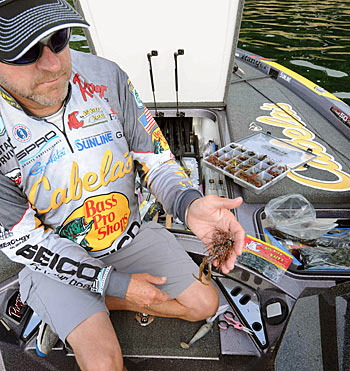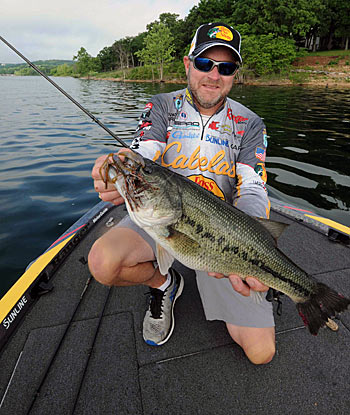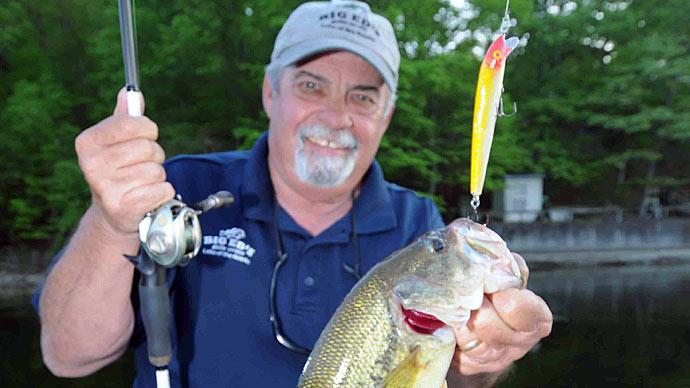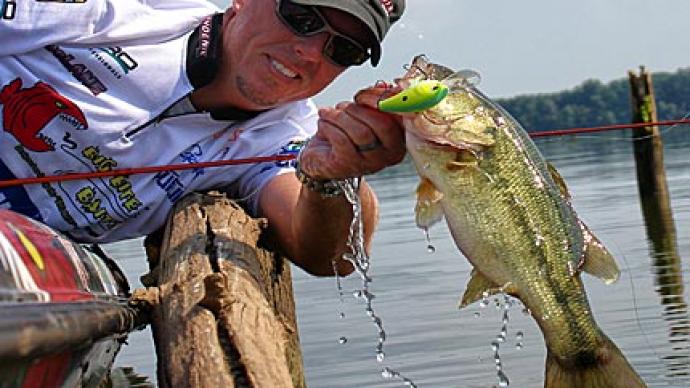
The post-spawn can be a time for either slowing down or speeding up to catch recuperating bass.
Bassmaster Elite Series pro, Mike McClelland, acknowledges there is a period during the post-spawn when bass get sluggish while recuperating from the rigors of spawning and prefer slower-moving lures. “I don’t know when that window is because I don’t know exactly when every fish spawns,” McClelland says. He also notices that once bass get past that phase, the fish get “super aggressive,” especially when they start schooling and chase faster moving baits.
So, McClelland favors throwing a lure throughout the post-spawn that he can retrieve at various speeds. “There are so many ways to catch bass during that post-spawn period, but for me, I like to throw a bulked-up football jig,” he says. “A crankbait is a phenomenal post-spawn bait, but it is one of those baits that you almost have to have the perfect water conditions. A football jig is one of those baits that, regardless of the clarity of the water, you can typically catch fish on it. You can work it in so many different manners. You can stroke it or drag it on the bottom.”
“Sometimes you have to drag it around to get the first bite, but once you get that first bite and get the school fired up, you can stroke the jig or even swim it at times,” McClelland says. “You can throw it out, let it hit bottom, and then almost wind it as we do with a hardhead (jig) or something like that.”
Football jigs can be used as finesse baits by selecting smaller jigs and trailers. Still, McClelland favors beefing up his baits by selecting larger jigs and “bigger than average” soft plastic trailers, such as the Big Bite Baits Creature Bait or Battle Bug for hungry post-spawn bass. “They generally want to eat big baits then,” McClelland says.
A couple of factors determine which size jig McClelland selects during the post-spawn. “You have to consider the type of lake and the depth the fish go to,” he says. “Sometimes in the post-spawn period on Ozark lakes, it seems like you catch bass as deep as you will catch them right during that period when they start feeding back up.” When those fish feed in deeper water, McClelland favors jigs ranging in size from 5/8 to 1 ounce.
For shallow-water presentations, McClelland usually opts for a 1/2- or 5/8-ounce football jig, but sometimes he uses heavier jigs in the shallower water to trigger reaction strikes. “The speed the fish want the bait to be can be a real key,” McClelland says. “There are times I have caught bass on a 3/4 or 1 ounce in water less than 15 feet deep because the fish wanted that bait moving fast.“

The Arkansas pro likes contrast when choosing his jig and trailer colors. “A lot of guys, if they throw a black-and-blue jig, tend to go with a black-and-blue or a blue trailer,” McClelland says. “But I like to mix and match a little bit. If I throw a lighter color, such as watermelon or a light green pumpkin jig, I like to make my trailer slightly darker.”
McClelland also dotes on dipping his soft plastic trailer in chartreuse garlic scented dipping dye. He believes post-spawn bass feed heavily on bream, so he dips the tail of his trailer in chartreuse dye to mimic the shiny chartreuse tail of bluegill.
Power generation frequently determines how McClelland retrieves his football jig during the post-spawn. He notices bass tend to suspend more over ledges and points when there is no current from generation, so he prefers “stroking” the jig than with a vertical presentation.
The eight-time B.A.S.S. winner starts his stroking presentation with a short cast to a steep ledge and then lets the jig hit bottom. After dropping his rod to the 9 o’clock position, he pops it up to 11 o’clock and holds it there for a short while before popping the rod again and lifting it to the noon or 1 o’clock position. McClelland estimates this double hop causes his jig to rise 6 to 7 feet off the ledge. Then McClelland lets his jig fall on a “relatively slack line” and keeps a close vigil on the line. If the line stops falling before all the slack straightens out, McClelland sets the hook because he knows a bass has inhaled his jig on the fall.
When McClelland notices a lot of current from generation is sweeping across main lake structure, he tries to keep his jig closer to the bottom. He knows bass are staying closer to the bottom and using ambush points along specific parts of the structure where current is running across the hardest. So, McClelland makes a long cast across structure, such as a main lake point, and employs a series of hops to make his jig lift and fall about 1 1/2 to 2 feet off the bottom.
McClelland throws most of his football jigs on a 7-foot, 4-inch Falcon Expert Series heavy cover Jig rod, but he opts for a 7-foot, 6-inch Falcon Expert Series flipping stick for working a 1-ounce football jig. He favors a Cabela’s Arachnid by Daiwa 8.1:1 baitcast reel that allows him to reel in line quickly for a better hookset. His football jig tactics require a sensitive line that doesn’t stretch on the hookset, so he opts for 16- to 20-pound Sunline Shooter Fluorocarbon.
BassResource may receive a portion of revenues if you make a purchase using a link above.




